Thai Wedding
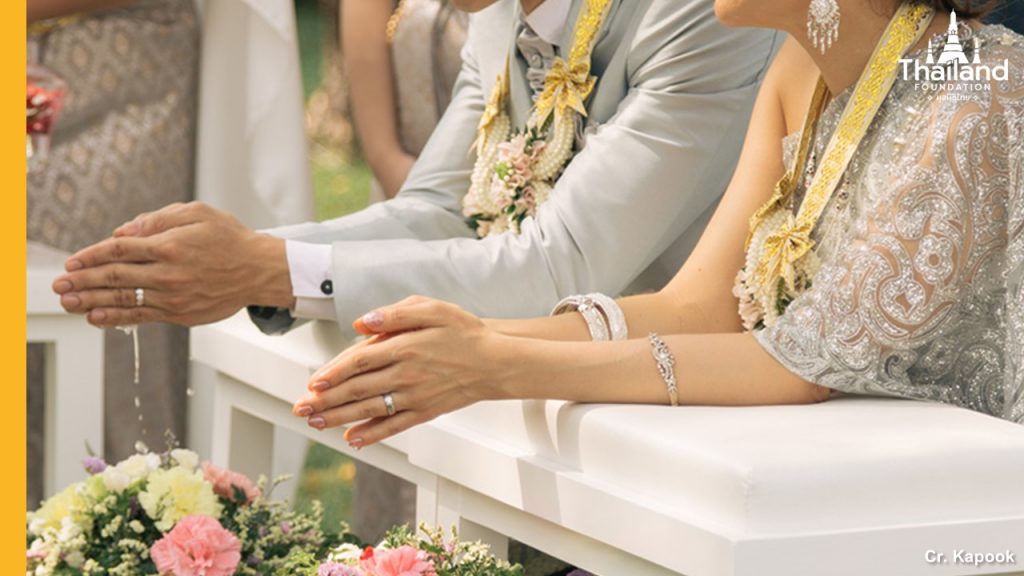
When it comes to weddings, couples from different parts of the world have their own tradition of celebrating another chapter of their lives, and Thai lovers are no different. A Thai wedding ceremony is the epitome of our rich culture, characteristics, and beliefs.
As a foreigner, attending your first Thai wedding might be a totally new experience. Don’t worry! We are here to guide you step-by-step through what may seem to you like complicated processes, and by the end of this article, you will walk into the ceremony with confidence!
Elements of Thai Wedding
In the old days, Thai engagement and wedding ceremonies were conducted on separate dates. These days, however, the engagement and wedding ceremonies are done on the same day to make it more convenient for both the couple and the guests. The day is divided into morning ceremonies, to which immediate families and close friends are invited, and an evening reception for other families, friends, and acquaintances. The traditional morning ceremonies, especially in the Central Region, consist of the following steps:
- Buddhist ceremony
On this auspicious occasion, Thai people usually invite nine monks to perform a Buddhist ceremony to raise their morale. The monks’ blessings are believed to eliminate all the sorrows and encourage the couple to maintain a long, healthy relationship. The monks will also pray and bless water to make holy water which will be used later in the ceremony. Then, the couple will make merit by offering the monks food. This is also an important part of the wedding because it is believed that when the couple hold a rice ladle together, the person whose hand is placed above the other’s will have the upper hand in the relationship, and, usually, it will be the bride! After the monks finished eating, they will continue praying and will bless the couple and the guests with the holy water, so be prepared to get holy water sprinkled on you!
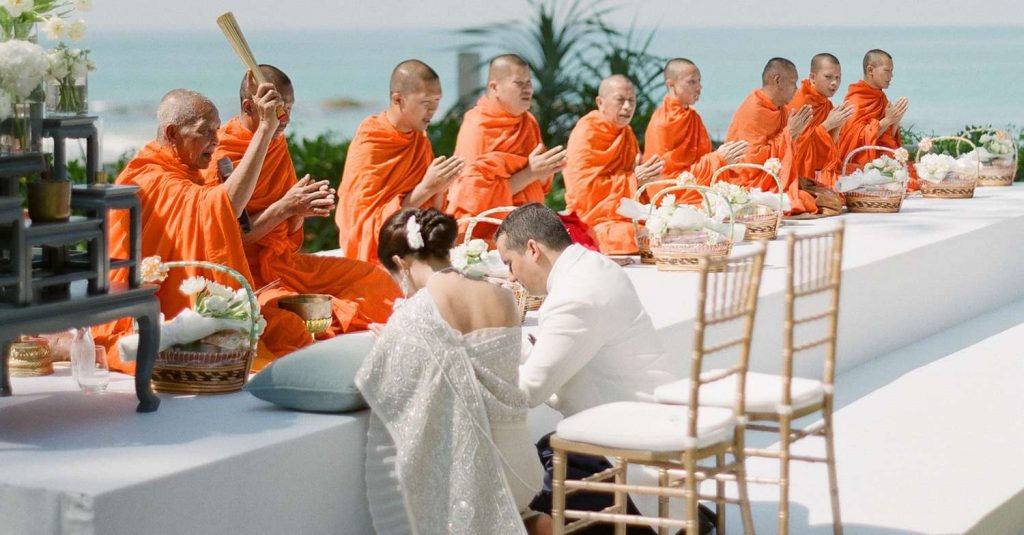
(Photo credit: Brides)
- Khan Maak procession
The groom, along with his family and friends will form a procession to carry khan maak [ขันหมาก] or engagement trays to the bride’s house. The items on the trays are sinsod [สินสอด] or dowry, an engagement ring, betel nuts, incense sticks and candles, grains, and other auspicious items, all of which represent love, prosperity, fertility, and longevity in Thai culture. The procession is very cheerful as people sing and dance along to the beats of traditional long drums.
When the procession arrives at the bride’s house, it is immediately blocked by the symbolic “gates”. These gates are called “pratoo ngoen” [ประตูเงิน] or silver gate and “pratoo tong” [ประตูทอง] or golden gate which are actually silver or gold belts or chains held by the brides’ female relatives and friends. To be able to get through each gate, the groom, or the respected senior on the groom’s side needs to provide money envelopes as a “toll” for the gatekeepers. The groom may be given a hard time as the gatekeepers usually ask him to complete a funny quest or jokingly tell him the toll isn’t enough to gain access. They need to negotiate well since the amount of money asked will increase with each gate opened.
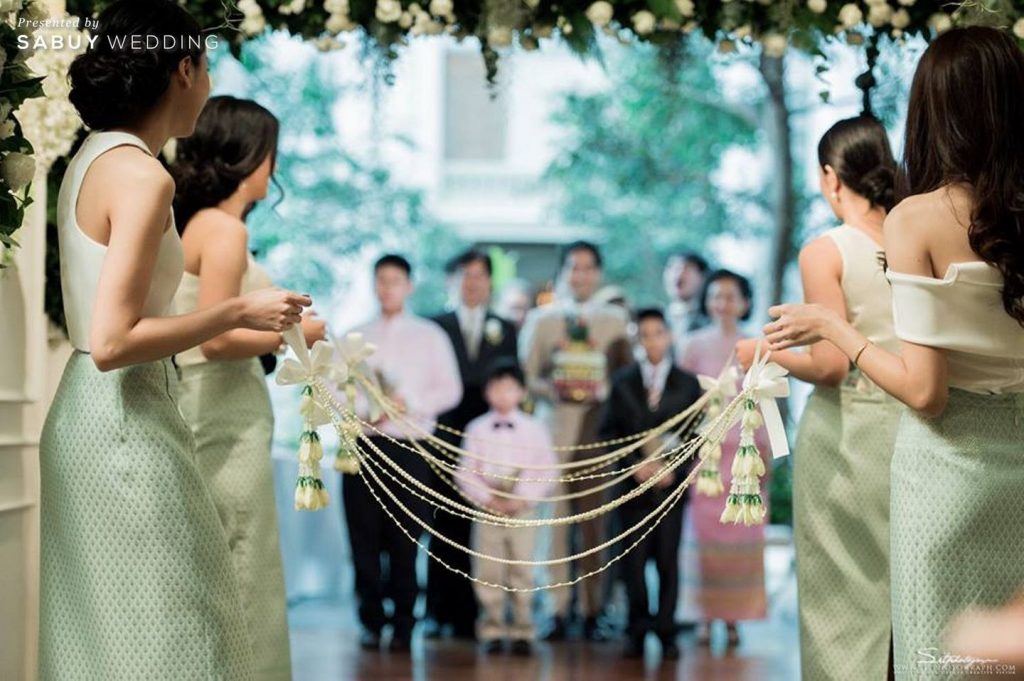
(Photo credit: Sabuy Wedding)
- Proposing and checking the dowry
Upon entering the house, the engagement trays will be laid on the main table and both the bride and groom, along with their parents and the respected seniors on both the bride’s and groom’s side, will be asked to come up. The groom’s senior or parents will introduce themselves and propose to the bride in the name of the groom. Then the dowry will be presented for the bride’s family to check. The couple’s parents will pick some grains, popped rice, and flowers from the engagement trays and sprinkle them on the dowry while giving blessings. After that, the bride’s mother will carry the dowry on her shoulder, pretending that it is very heavy, before putting it down. Nowadays, giving the bride’s family dowry has become more like a symbolic act for most families. The bride’s parents may give the dowry back to the couple after the wedding so as to help them start their new family life.
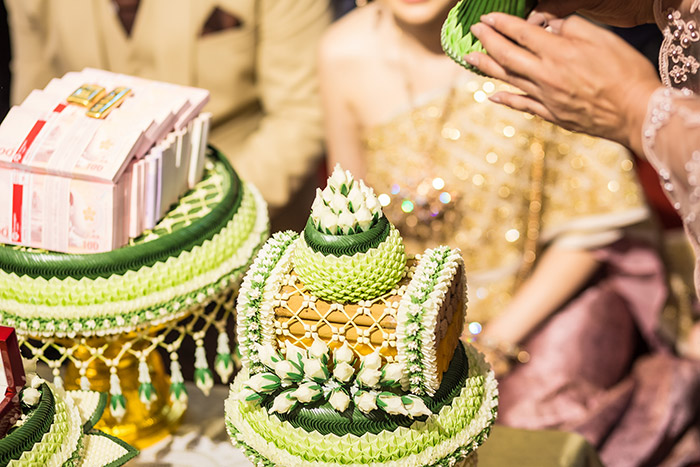
(Photo credit: Kapook)
- Engagement ceremony
During this ceremony, the bride has to pay respect to her future husband by pressing her hands together and bowing down to place them on the groom’s chest or lap, while he also presses his hands together as a sign of receiving respect. Then they will exchange engagement rings. This practice has, in fact, its roots in the Thai patriarchal society in the past where men were the leaders of the society and acted as women’s caretaker and protector. However, as Thai people become more aware of gender equality, this ceremony has become just a symbolic act without the intention of perpetuating gender inequality in the society. Some couples even adjust the tradition by both performing the wai gesture to show respect towards each other.
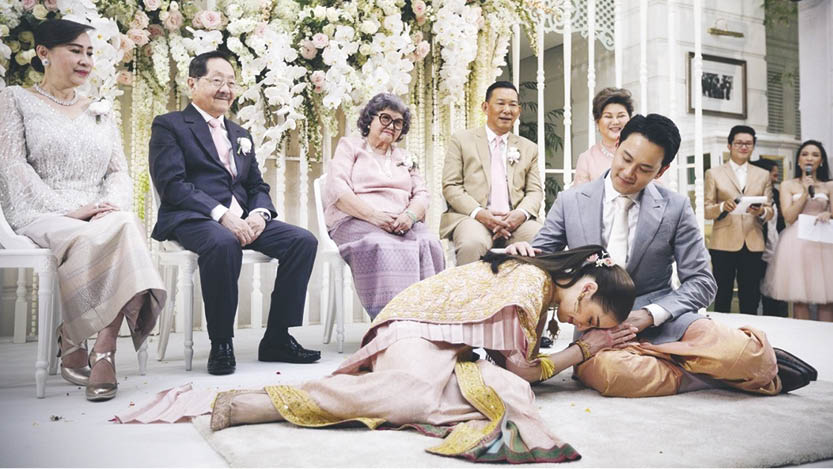
(Photo credit: Khaosod Online)
- Paying respects to elders
As Thais place great importance on respecting adults, the couple pays respect to their parents and older relatives, and, in return, they are gifted with blessings or money.
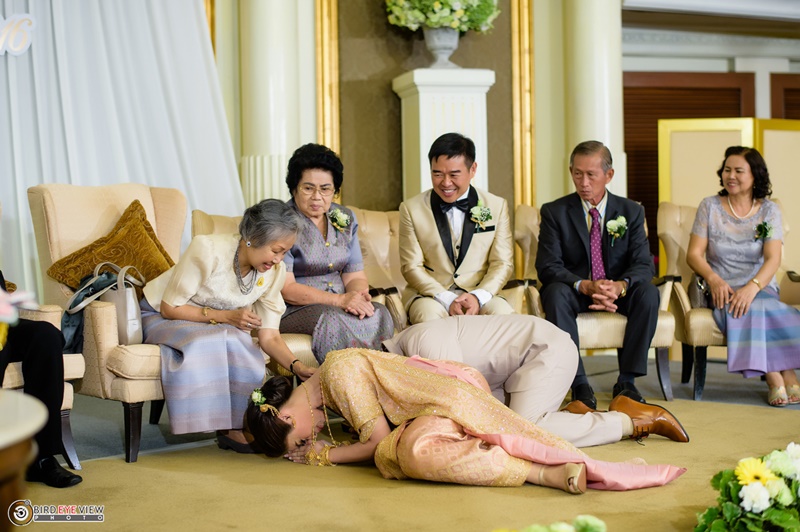
(Photo credit: Wedding List)
- Rod nam sang [รดน้ำสังข์] or conch shell blessing ceremony
In this ceremony, the couple wears holy garlands around their necks and kneel on a pedestal, holding their hands out. This is where the guests take action by pouring holy water out of a conch shell on the couple’s hands while giving them blessings and a money envelope. In return, the guests will receive a small keepsake from the wedding.
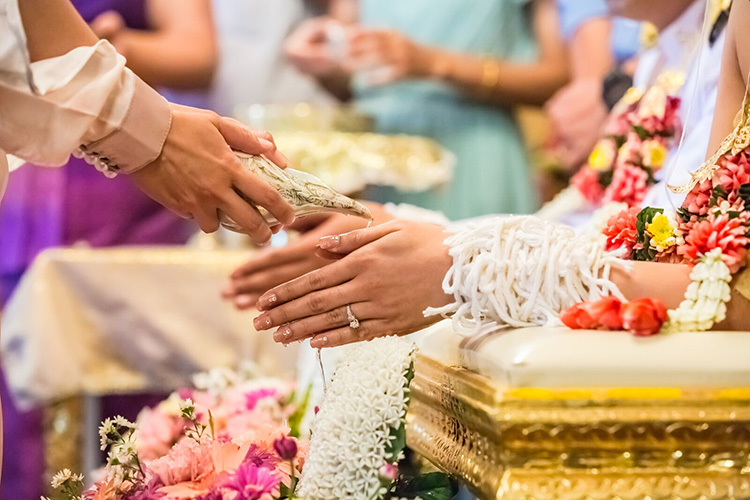
(Photo credit : Sarasod)
- Bedding ceremony
At last, the final ceremony begins! The newlyweds will be led to their honeymoon suite in which an old couple who represent a long and successful marriage wait for them after preparing the bed with various auspicious items that are the symbols of prosperity and fertility. Then, the couple will lie down with the bride on the left side and the groom on the right. They will lie still, pretending to be sound asleep, and, after a while, they will “wake up” and talk about their “dreams”. The dreams are often what Thai consider auspicious, for example, dreaming of holding an infant can be interpreted that the bride will be pregnant soon, or dreaming of holding a crystal ball means their future baby will be born cute and healthy and will grow up to be a successful person who builds good reputation for the family.
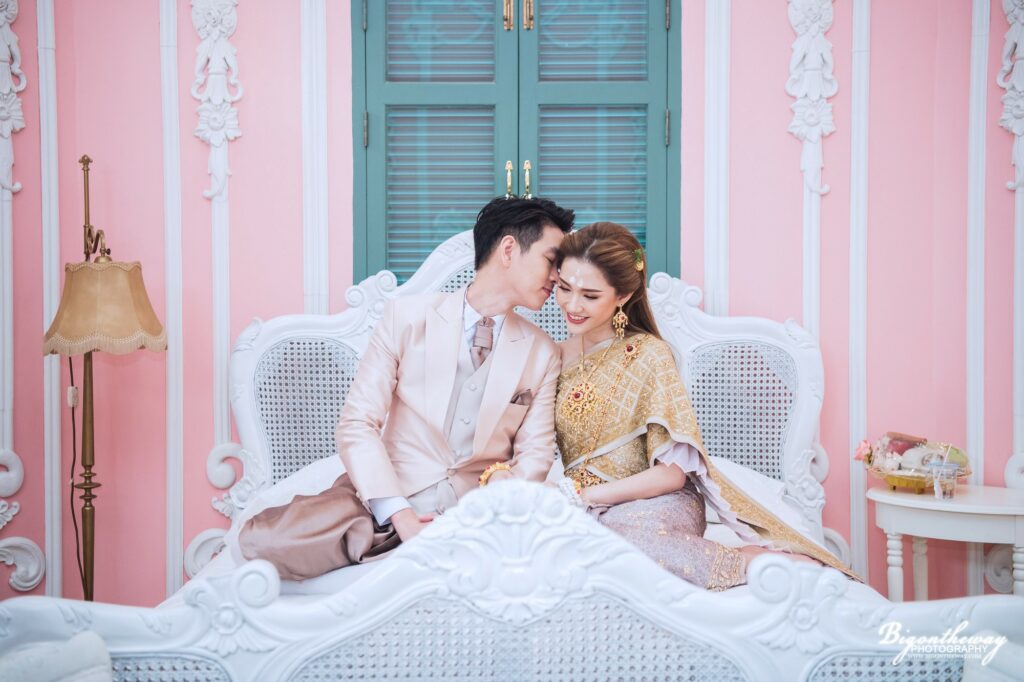
(Photo credit: VenueE)
As the morning ceremonies are organized in Thai traditional style, the bride and groom usually wear Thai traditional dress. The evening reception, on the other hand, is usually what you would expect to see at a western wedding reception where a suit and a white gown are worn. There is also the familiar cutting cake event. During the toast to the bride and groom, there is a special ritual to wish success upon the couple. The toast master will hold up the glass after delivering the speech. Guests will stand up, after which, the music in the background will play the song Maha Ruek [มหาฤกษ์] or “The Song of Great Occasion”. This song is commonly played during the opening of an important ceremony, for example, a foundation stone laying ceremony or, in this case, a wedding, to indicate the auspicious time for the event. When the song ends, the toastmaster will lead the crowd in chanting out loud “Chai Yo!” (Victory!) three times (similar to the Western “Hip Hip, Hooray!”).
No matter what style the wedding is organized in, don’t expect to go home with an empty stomach! Food is an important element for Thais, so the host will surely prepare loads of food and beverages for their guests, no matter if it comes in courses or cocktail reception.
Regional Variations
Each region in Thailand has its own traditions when it comes to wedding ceremonies. Here are some examples:
- The Northern region
The uniqueness of a Northern Thailand wedding ceremony begins with the khan maak procession, where, instead of carrying a tray containing flowers and incense sticks, the groom usually carry a sword and a chest. The Northern wedding combines many steps into one: the Baisri Sukwan [บายศรีสู่ขวัญ] or blessing ceremony, where the couple exchange rings, and a spiritual leader is invited in place of monks to pray and bless them. After that, he and the couple’s families will bind holy threads around the couple’s wrists as an alternative to the shell ceremony.
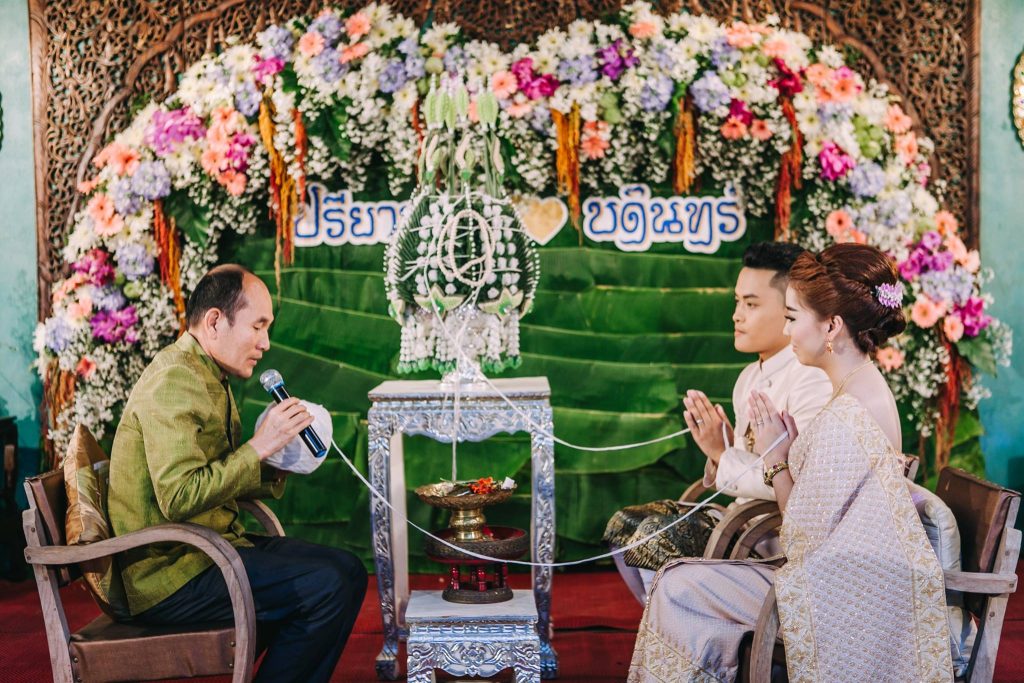
(Photo credit: Weddinglist)
- The Northeastern region
The Northeastern wedding is known for a joyous feast hosted for relatives, friends, and neighbors who come to give support and help prepare the wedding at the bride’s house before the wedding day. They would also invite monks to deliver a sermon. However, on the wedding day, they often invite a Brahmin priest to attend Baisri Sukwan ceremony, similar to that of the Northern one. The bride and groom will then give a sarong, a long piece of cloth used to wrap around the waist, and a shirt to each of their parents after paying them respect.
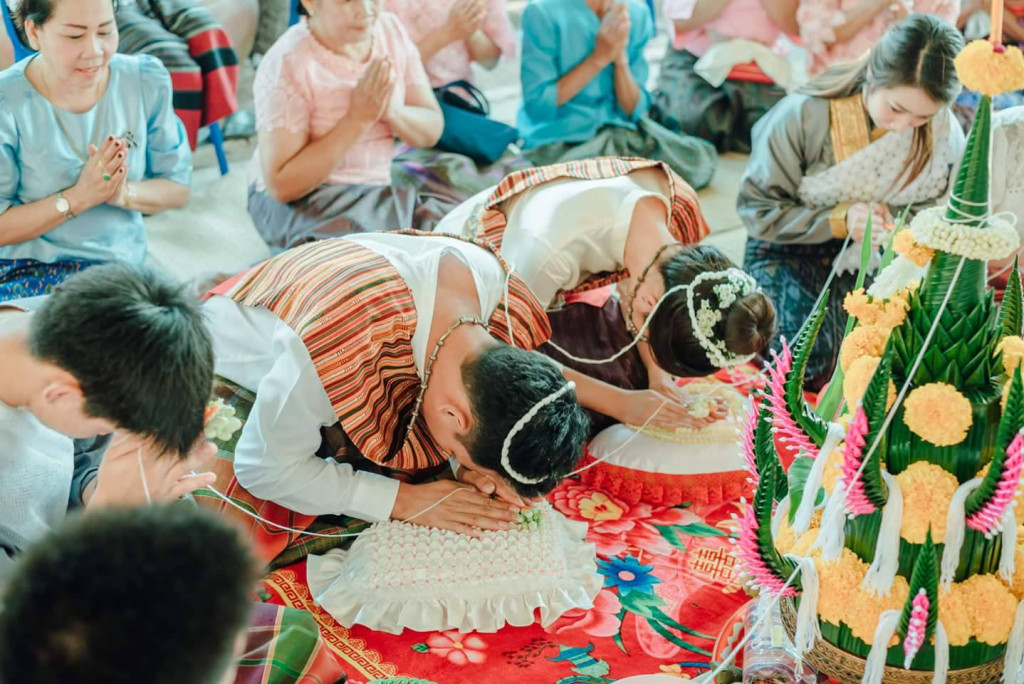
(Photo credit: Moneyrental888)
- The Southern region (Buddhist wedding)
Just like the other regions of Thailand, Buddhism is still the largest religion in the South. Therefore, when it comes to a wedding ceremony, the majority of people often organize it in a Buddhist style similar to that of the Central region, for example, nine monks will be invited and there will also be a khan maak procession to the bride’s house. So, if you have already attended some Buddhist wedding ceremonies in Thailand and are invited to the Buddhist one in the Southern part of Thailand, you don’t have to worry at all as they are probably organized in the same way!
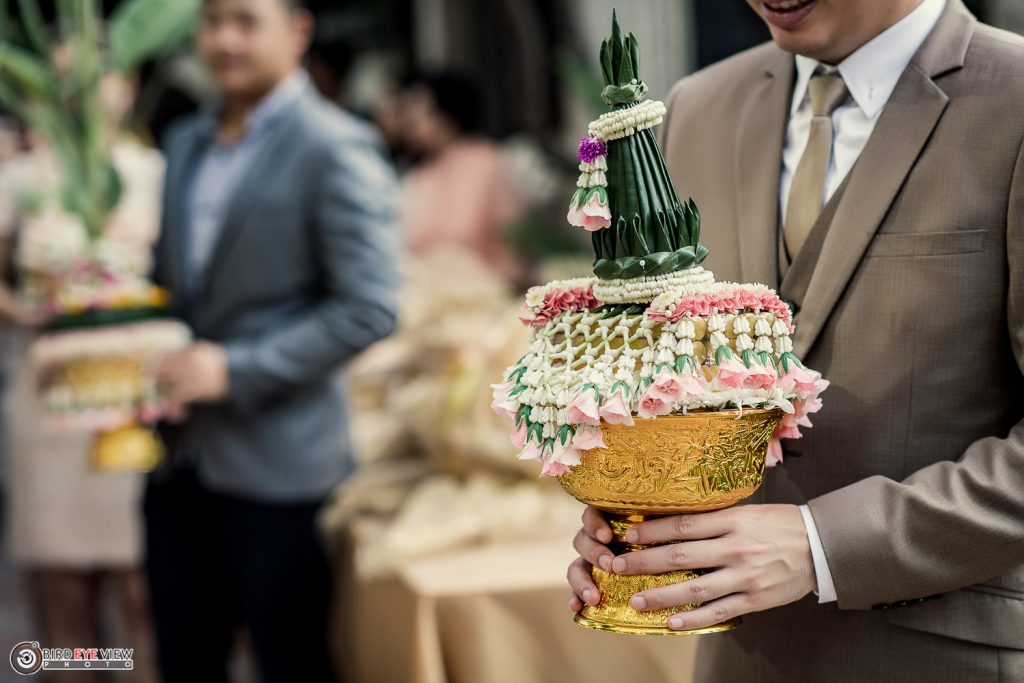
(Photo credit: WeddingList)
- The Southern region (Muslim wedding)
Although the majority of Thais are Buddhists, Thailand’s southernmost provinces of Satun, Pattani, Yala, and Narathiwat are home to a large Muslim population. Therefore, the Islamic cultures and traditions are practiced in this part of Thailand. A Muslim wedding ceremony, or Nikah, is an unique event. Generally, a man’s mother will propose to the bride-to-be in his name. On the engagement day, there is a khan maak procession to the bride-to-be’s house. At this stage, the man is still not allowed to touch his fiancée. They have to wait until the Nikah day, held within 2 weeks after the engagement at a mosque or the bride’s house. During Nikah ceremony, the bride has to wait inside a room while the groom attends the ceremony beginning with an imam or officiant reciting verses from the Quran, the Muslim holy book, and giving a short sermon. The bride’s father will give the groom permission to marry his daughter after asking for her consent. Then, the ceremony will continue until the end and the groom can go and see his bride.
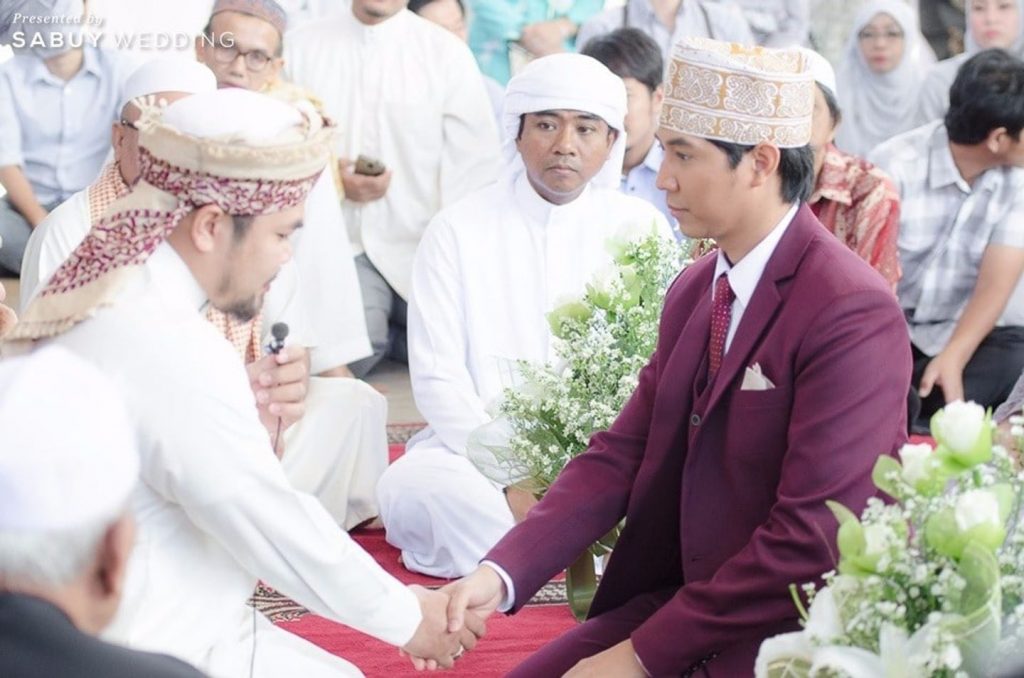
(Photo credit: SabuyWedding)
- The Southern region (Peranakan or Baba’s wedding)
The wedding of Thai Baba [บาบ๋า] or descendants of Chinese immigrants and locals in Phuket Province, is a mixture of both Chinese and local traditions. Held annually, the wedding is an elegant and vibrant event that everyone in the community helps organize. During the khan maak procession, firecrackers are lit to scare off evil energy and add to the lively atmosphere. One of the most significant ceremonies is the Wedding Tea Ceremony, where the couples kneel in front of their parents and older relatives while offering them tea, showing their respect and appreciation. The couple’s wedding outfit is also unique. The bride wears a colorful, long lace dress with batik sarong, and a set of traditional accessories and a tiara, while the groom wears a vintage western-style suit.
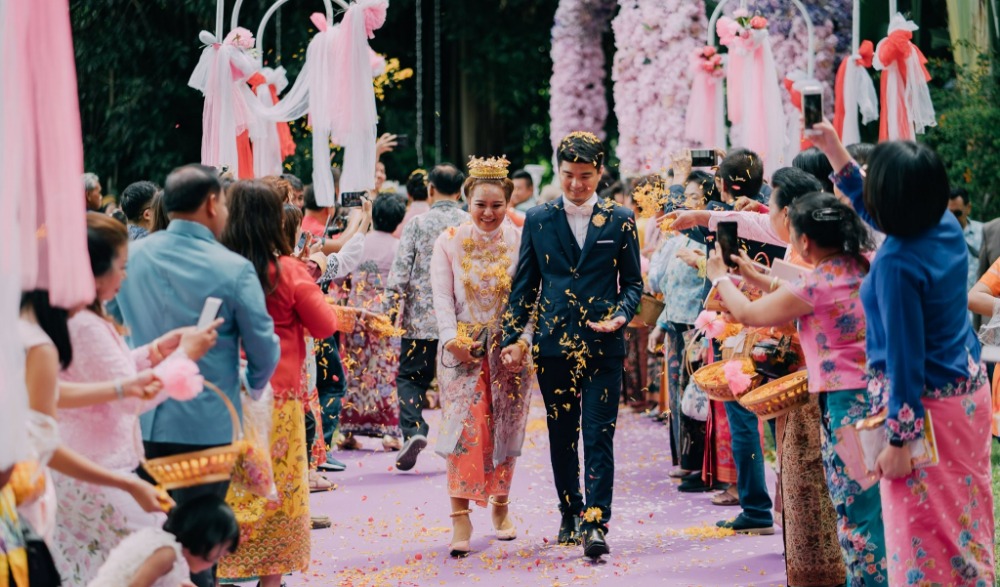
(Photo credit: DailyNews)
What to Expect When You Are Invited to a Thai Wedding?
- Wedding invitations and wedding gifts
Though some people may give wedding gifts to the bride and groom, the majority of the people, however, give cash to the couple. This is done mostly to help cover the wedding costs and to allow the couple to buy whatever they desire. When you receive an invitation, don’t throw the envelope away as it is normal to put the cash inside that envelope and bring it to the wedding where there is a money box for it. The amount of cash depends on your intimacy with the couple, income, and social status. If you are invited but can’t make it to the wedding, you can ask someone who will attend to bring your envelope there.
- What to wear?
If you are invited to a morning event, you probably have to prepare yourself for hot and humid weather. Especially if you are the groom’s guest, participating in the khan maak procession can tire you out. It is advisable to wear smart casual attire. However, some weddings may require formal wear, so consult with the host for safety. For ladies, dress modestly and avoid bare shoulders or short skirts as there will be a religious ceremony. However, if you are attending an evening reception, you can dress just like when you attend a western one. Usually, there is a color dress code for guests stated on the invitation card, but if there isn’t, don’t be afraid to ask the host about it.
- How to act as senior guest?
If you are lucky, you might be invited to the wedding as a senior guest. Perhaps you are the bride’s or the groom’s parent, boss, or just someone they have utmost respect for. As you may have deduced by now, the bride’s and groom’s seniors play an important role in the rituals of the event. Do not be alarmed, as the standard rule for attending any events still stands: act respectfully and you will be fine. During Buddhist ceremonies, especially during the chanting, Thai people often perform the wai gesture as a symbol of respect towards the monk. If you are of a different faith, you may politely place your hand upon your laps. If you are invited to give a toast to the bride and groom, be ready to lead the crowd in the victory chant. Some events, however, may not include the victory chant. Thus, it is important to play-by-the-ear and follow the person giving the toast before you.
A Deeper look
In this section, we’re going to dive deeper into the elements of Thai weddings. It’s amazing how a single event like a wedding can represent so much of our beliefs and way of life. Let’s begin with the first event in the morning – the Buddhist ceremony. As the nation’s largest religion, Buddhism plays integral role in many aspects of Thai society and culture. The inclusion of Buddhist elements in weddings shows our faith and belief in Buddhism and in making good merits for good luck and a successful future. There is also a belief that if a couple makes good merit together, they will be destined to be soulmates again in their next life. This directly reflect the belief in reincarnation and the law of karma, whereby the accumulation of good deeds will result in good fortune in this life and the next.
Apart from that, Thai people’s faith and belief in Hinduism is also present in our wedding ceremony. What Hinduism brought to the Thai psyche is the knowledge in astrology as well as an appreciation for proper rituals. This psyche is represented through the conduct of rituals during many important occasions in our lives, including our wedding. We delicately choose and include various propitious factors to raise our morale at such important moments. For example, we almost always consult an astrologer to find an auspicious date and time for the engagement and wedding. We also include many auspicious items representing prosperity, fertility, long-lasting love, and more. For instance, such item as a conch shell is considered an indispensable item in the blessing ceremony for certain reasons: Hindu legend has it that a demon in a conch swallowed the Vedas, the most ancient Hindu scriptures. The god Vishnu then fought with it and finally got the Vedas back by snatching it out of the conch’s mouth, so we use a conch shell to perform an auspicious act as it used to contain the Vedas and it is believed that the fingerprint of Vishnu is on its mouth. And because of the conch shell’s pure white color, the water that flows out will be holy, meaning that it is suitable for watering in various events, including weddings.
Many ceremonies also reflect our way of life in the past. Take khan maak procession for example. Every procession must include betel nuts as khan means bowl or tray and maak means betel nut. You may wonder why maak is so important for us. Well, chewing it with betel leaf, and red limestone paste was a popular activity in the past in which not only the peasants but also aristocrats and royal families participated. The red or brown stain on the teeth of those who chew maak was considered a beauty standard at that time, so maak became an integral part of Thai people’s lives. However, as time goes by and with the influence of Western cultures, our way of life has also changed. Today, Western ceremonies are incorporated into our traditional wedding, making it even more unique.
Lastly, a wedding is also considered a family and friends gathering event. In some regions, they even come and help organize the wedding along with the bride’s and groom’s families. By gaining support from their loved ones on their important day, there is no doubt that the couple is beyond grateful, and this helps strengthen the family bond and friendship to another level.
Conclusion
Thai wedding reflects three main characteristics of Thai people which are respect, compassion, and openness. During the wedding ceremonies, it is evident that Thais put a lot of importance in showing our faith in Buddhism and our respect for adults. We do not only show our reverence for the seniors just to follow the traditions, but we really want to express our gratitude since they have raised and supported us throughout our lives. As for compassion, the kindness of Thai people is reflected through the gathering of the couple’s families and friends to offer their love and support, and some even come to help organize the wedding. At the same time, the couple returns their kindness by throwing a party, offering a feast, and small souvenirs for them. Lastly, Thai people are known for our openness. The combination of Buddhism and Hinduism, as well as the incorporation of various cultures, be it Western, Chinese, or Muslim in the wedding, show that we welcome different cultures with an open heart.
Now that we walk you through all the steps and fun facts about Thai wedding, this special occasion doesn’t seem that complicated after all, right? So, for the upcoming wedding, no matter if it is your Thai friend’s one or even your own, you can now walk in with confidence! We wish you the best of luck!
The story of “Thai Wedding” is a beautiful part of Thai culture and heritage. We saw how the essence of Thainess is represented through respect for elders and religious teachings, compassion among family and friends, and openness towards different ways of celebrating marraige. Join us in exploring more stories of Thailand and the Thai people, as we take you on a journey to discover Thainess.
Sources
- https://bit.ly/3IapkOZ
- https://bit.ly/3lPvHzv
- http://bitly.ws/BAkP
- http://www.openbase.in.th/node/7362
- https://praewwedding.com/planning/101700
- https://praewwedding.com/thai-wedding/24982
- https://www.weddinglist.co.th/blog/isaan-wedding/
- https://learnthaiwithmod.com/2015/10/thai-wedding-party
- https://www.phuket.net/articles/2019/06/phuket-baba-wedding
- https://www.theknot.com/content/muslim-wedding-ceremony-rituals
- https://www.thaizer.com/advice-for-guests-invited-to-a-thai-wedding
____________________________________________________________________________________________________________
Author: Thanachporn Varapongsittikul
24 April 2023


